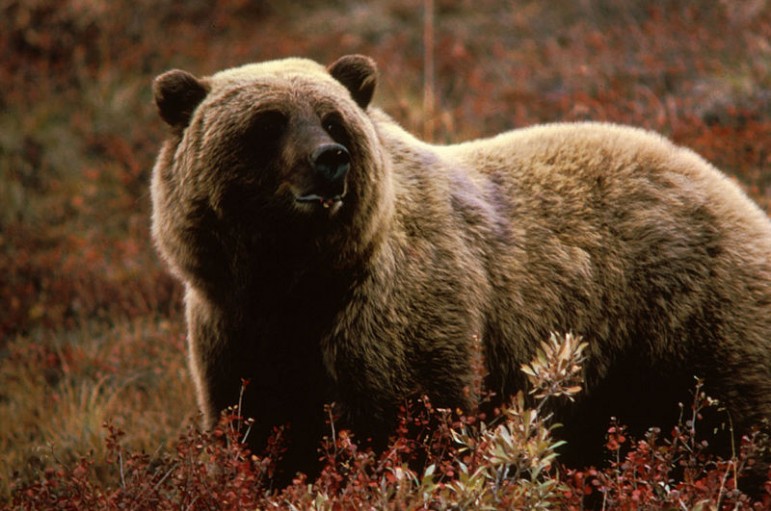
CODY, WYO. — There’s no guarantee of safety when hiking in grizzly country, but following a few basic safety guidelines can reduce the odds of having a bad encounter with a bear. Unfortunately, too many hikers either don’t know those basics, or ignore the advice that experts offer.
That’s one of the key findings from a report released Thursday by a panel that investigated the death of Lance Crosby, who was killed in August by an adult female grizzly bear in Yellowstone National Park.
Crosby, 63, from Billings, Montana, was found dead less than a mile from the Elephant Back Loop Trail in a popular off-trail area near Yellowstone’s Lake Village.
The adult female that attacked Crosby was captured and euthanized, while her two female cubs were captured and sent to an Ohio zoo.
Park officials said last year that a key factor in their decision to kill the mother grizzly was that “a significant portion” of Crosby’s body was eaten by the bear, and then cached (hidden or covered)—behavior that signals the bear planned to return later to resume feeding on the body. Such behavior is abnormal in typical defensive attacks by female bears defending their cubs.
The report details extensive DNA and other physical evidence confirming that the adult female was responsible, and that the incident may have taught her cubs to view humans as a food source.
The report, compiled by nine state and federal bear biologists based in Wyoming and Montana, found that Crosby failed to follow several key safety recommendations for staying safe in grizzly country.
Crosby was a long-term seasonal employee of Medcor, the company that operates three urgent care clinics in the park. He had worked and lived in Yellowstone for five seasons, and was an experienced hiker. But at the time of the fatal attack, he was hiking alone and without bear spray, according to the report.
Crosby’s family and friends “stated that he often hiked alone, often hiked off-trail, and never carried bear spray,” the report said, and that he “believed carrying bear spray would make him ‘complacent,’ and that he thought it better to remain vigilant and rely on his senses to avoid confrontations with bears.”
Because he was not carrying a camera, phone or camping gear, Crosby was likely out for a short day hike, the report states.
Similar to how some drivers don’t buckle their seat belts on short trips, quick hikes and brief walks in the woods are common scenarios when even experienced naturalists often fail to take along bear spray or follow other recommended precautions.
A recent survey of 7,770 people day-hiking in Yellowstone National Park found that only 14 percent carried bear spray.
The review panel that investigated Crosby’s death noted that state and federal land managers engage in a wide range of bear safety outreach and education efforts, but “adherence to these safety practices is generally low, indicating that current messaging is not successful at changing peoples’ actual behavior in bear country.”
The panel recommended that land and wildlife managers continue working to improve their education programs, “with the goal of achieving greater adherence to these safety practices by all recreationalists, and among day-hikers in particular, who have a low level compliance with bear safety procedures.”
The report recommends five key grizzly country safety guidelines:
- Be Vigilant: Keep en eye out for bears, tracks, scat and other warning signs, especially when hiking off-trail.
- Carry Bear Spray: It can be effective in stopping aggressive bears during surprise encounters, provided you keep it accessible and know how to use it.
- Make Noise: Alerting bears to your presence can help avoid surprise encounters.
- Don’t Run: You won’t outrun a charging bear, and running can trigger a chase response.
- Hike in a Group: Hiking in groups of three or more, or traveling by horseback, will greatly reduce the risks of bear attack.
Contact Ruffin Prevost at 307-213-9818 or [email protected].

Why are surprised when we are attacked , mauled are partially eaten when we enter “their” territory ?
You take a chance every time you hike , hunt or camp in the wilderness .
Food may be scarce at the time you are there and anything warm blooded is perceived as food .
I will never condone an animal being killed and her babies doomed to a lifetime in a cage – just for doing what they are created to do .
I totally agree. Its atrocious that an “experienced” park employee fails to follow bear protocol rules; goes out in “bear country” by himself without a phone or spray, during cub season. When a wild mother bear sees him as food for her cubs, she is killed and the cubs locked up for the rest of their lives because of poor choices the hiker made. That is wrong, wrong, wrong. During cub season, NO one should be allowed off designated trails to give mother bears the safety from US to feed and raise their cubs. I was a hiker when I was younger and I live in WA state. Bears are in our woods here. I went prepared, and knew that bears are a risk. Go prepared or assume the risk being unprepared creates when we go into the dwindling territory of bears. Its their world we are entering. WE take the risk.